Toyota JPN Taxi
This article needs additional citations for verification. (November 2017) |
| Toyota JPN Taxi (NTP10) | |
|---|---|
 A Nihon Kotsu Toyota JPN Taxi. | |
| Overview | |
| Manufacturer | Toyota |
| Also called | Toyota Comfort Hybrid (Hong Kong) |
| Production | October 2017 – present |
| Assembly |
|
| Body and chassis | |
| Body style | 5-door station wagon |
| Layout | Front-engine, front-wheel-drive |
| Platform | Toyota B platform |
| Related | Toyota Sienta hybrid (XP170) |
| Powertrain | |
| Engine | 1.5 L 1NZ-FXP I4 |
| Electric motor |
|
| Transmission | 1-speed planetary gear |
| Hybrid drivetrain | Full hybrid (THS II) |
| Battery | Nickel–metal hydride |
| Dimensions | |
| Wheelbase | 2,750 mm (108.3 in) |
| Length | 4,400 mm (173.2 in) |
| Width | 1,695 mm (66.7 in) |
| Height | 1,750 mm (68.9 in) |
| Chronology | |
| Predecessor |
|
The Toyota JPN Taxi is a taxicab sold by Toyota Motor Corporation. Toyota Motor East Japan is in charge of manufacturing the car for the Japanese market.
The JPN Taxi is based on the JPN Taxi Concept that was exhibited at the 43rd Tokyo Motor Show in 2013. It is a successor to the Toyota Comfort and the Toyota Crown Sedan.
Design[]
The passenger door on the driver's seat side is a hinged door that can easily distinguish the opened and closed state from the front and rear, and prevent the passenger from jumping forward.[1]
The vehicle is based around a "universal design" model. The rear passenger door is an electrical slide door and it is possible to get on and off in a wheelchair.[2] The rear seats also fold up, and a ramp folds out, to accommodate wheelchair passengers.[3]
The powertrain is based on the hybrid system "THS II" and newly adopted "LPG hybrid system" compatible with LPG fuel.[4] The engine uses 1.5L 1NZ-FXP, and an electric water pump that does not require auxiliary belt maintenance.
The battery is nickel hydride. In order to achieve a flat floor, the battery is thin in design and placed under the floor, and the vehicles exterior dimensions are in compliance with the Japanese Government's dimension regulations that allow tax savings for commercial use.
The dashboard and centre console differ from the related Toyota Sienta to allow the fitment of equipment for taxi operation, including an easily-accessible hazard light button on steering wheel at the driver's right thumb.
The rear cargo area is spacious enough to hold two large suitcases or four golf bags, while the passenger compartment offers nine inches of headroom due to its high roof.[2] The vehicle comes equipped with built-in soundproofing and air purification, while the high-end "Takumi" model includes a ceiling-mounted air circulator and a heating system for the rear seats.[4]
Safety[]
The JPN Taxi is equipped with 6 SRS (driver, passenger, front side & curtain) airbags as standard as well as Toyota Safety Sense.[5] The JPN Taxi also received a 5-star safety rating from JNCAP.[6]
Production and sales[]
From 2017 to 2020, the JPN Taxi was assembled by Toyota Motor East Japan at its Higashi-Fuji plant (Susono, Shizuoka). In December 2020, Toyota Motor East Japan moved the car production to its Miyagi plant (Ōhira, Miyagi).[7][8]
As of May 2018, the JPN Taxi accounted for around 10% of Tokyo taxis, while the traditional Toyota Comfort model accounted for around 70%. By mid-2020 (as the 2020 Summer Olympics in Tokyo were postponed to mid-2021 due to the ongoing COVID-19 pandemic), Toyota expects the JPN Taxi to account for about one-third of the Tokyo fleet.[3]
It debuted in Hong Kong in July 2018, sold as the Toyota Comfort Hybrid.[9] It was officially launched in January 2019.[10] The car is distributed by Crown Motors.[11] As of May 2019, 17 Comfort Hybrids are in service and are due to replace the Crown LPG taxis used in Hong Kong.[11]
Four of the taxis were brought to Hong Kong initially for research and field testing before they were adopted into service.[12]
Gallery[]
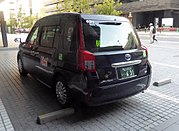
Rear view
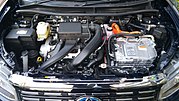
1NZ-FXP Engine with 2LM
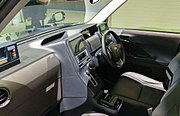
Interior
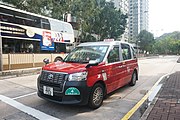
Urban Toyota Comfort Hybrid in Hong Kong
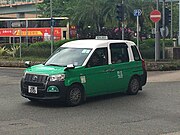
Hong Kong New Territories Toyota Comfort Hybrid
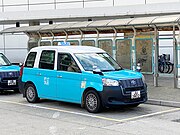
Hong Kong Lantau Toyota Comfort Hybrid
References[]
- ^ Brodie, James (2017-10-24). "Toyota JPN Taxi revealed ahead of Tokyo Motor Show". Auto Express. UK. Retrieved 2020-05-10.
- ^ Jump up to: a b Nishimoto, Alex (2017-10-23). "Toyota JPN Taxi is Japan's New Hybrid Cab". Motor Trend. US. Retrieved 2018-08-01.
- ^ Jump up to: a b Tarrant, Jack (2018-05-23). "Taxi! Tokyo prepares for Olympic tourism boom with accessible cabs and international drivers". The Japan Times Online. ISSN 0447-5763. Retrieved 2018-08-01.
- ^ Jump up to: a b "Toyota Rolls Out New Model for "JPN Taxi"" (Press release). Japan: Toyota. 2017-10-23. Retrieved 2018-08-01.
- ^ CORPORATION, TOYOTA MOTOR. "Toyota Rolls Out New Model for "JPN Taxi"". Toyota Motor Corporation Official Global Website. Retrieved 2020-06-20.
- ^ 邱志翔. "日本有史以來最安全的計程車!Toyota JPN TAXI獲JNCAP五顆星評價 - CarStuff 人車事". www.carstuff.com.tw (in Chinese). Retrieved 2020-06-20.
- ^ "トヨタ東日本、東富士工場の生産終了 東北に集約、小型車強化へ" [Toyota East Japan ends production at the Higashi-Fuji plant, consolidates production in Tohoku to strengthen compact/sucompact]. Kahoku Shimpo. 2020-12-11. Retrieved 2021-01-21.
- ^ Yabuki, Takafumi; Wada, Shota (2020-12-30). "センチュリーもヨタハチも トヨタ東富士工場、生産に幕" [Site of both the Century and the "Yotahachi", Toyota's Higashi-Fuji plant drops curtain on production]. Asahi Shimbun. Retrieved 2021-01-21.
- ^ Chan (2019-01-09). "Opposite Fare". Opposite Lock. US. Retrieved 2019-05-05.
- ^ Yau, Cannix (2019-01-25). "First hybrid Toyota taxis hit Hong Kong roads, but wider use will need incentives, industry says". South China Morning Post. Hong Kong. Retrieved 2019-05-06.
- ^ Jump up to: a b Yau, Cannix (2019-02-07). "New green engines for Hong Kong's iconic red taxis could give beleaguered industry a makeover". South China Morning Post. Hong Kong. Retrieved 2019-05-06.
- ^ Markowski, Robert (2017-12-06). "Hong Kong renews LPG taxi fleet". gazeo. Poland. Retrieved 2019-05-06.
External links[]
| Wikimedia Commons has media related to Toyota JPN Taxi. |
- Station wagons
- Front-wheel-drive vehicles
- Hybrid electric cars
- Hybrid minivans
- Partial zero-emissions vehicles
- Taxi vehicles
- Toyota vehicles
- Cars introduced in 2017
- Vehicles with CVT transmission






